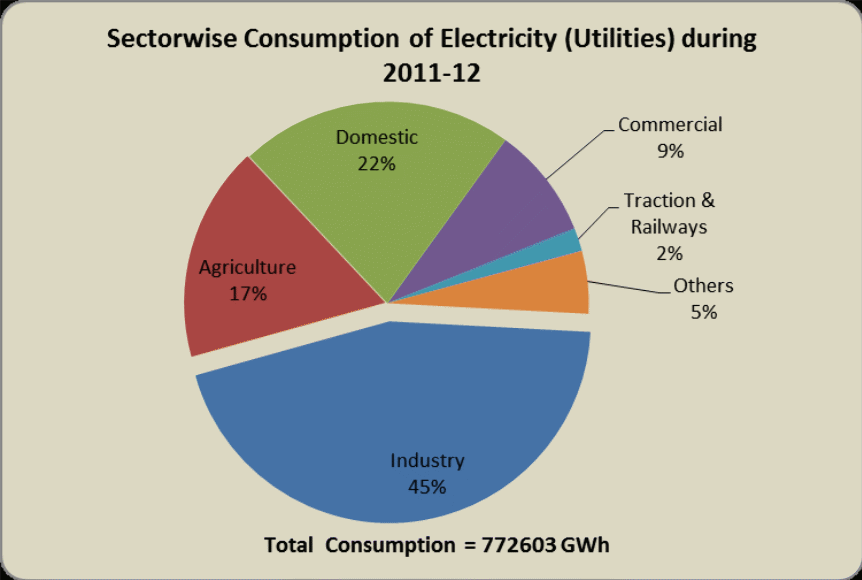Defining standby power
Standby power is the power consumed when most of the electrical products are switched off. Unknown to most consumers, most electrical products consume power when switched off unless the power cable is unplugged from the power supply. Therefore, in most households in the developed world power is consumed round the clock. Research shows that between the years 2011 and 2012, domestic power consumption was second after industrial consumption as shown in the diagram below (World population balance, 2013).

Standby power consumption
Although a single electronic device consumes an insignificant amount of power on standby mode, many devices will consume a significant amount. In a normal American household, more than 20 electric devices can be found (World population balance, 2013). These include a refrigerator, a microwave, oven, a television set, a DVD player, a radio, among other gadgets considered to be necessities. This is not the case in the developing world like India. This is why America is the greatest power consumer in the entire world. Standby power is still a concern in modern societies which impedes efficient energy consumption.
Standby power is a problem in the modern society
Effective consumption is threatened by the current modernization in emerging countries due to technological improvements. Many electronic gadgets are being introduced in the market and some have almost become basic requirements. Take for instance the use of computers in the modern world. Almost every household owns a computer or two in Canada. This further increases the consumption of standby power. Technology has changed the kitchen as we knew it and nowadays most of the things that were done manually can be done with an electric gadget. The challenge is that most of these products are regularly used so most people find it tiresome to plug in and out whenever they need to use them. This increases the number of electrical gadgets on standby hence increasing the power consumed in standby mode in a single household.
How to address the issue of standby power
To address the issue of standby power consumption, the national committee should consider a sensitization campaign. The power used in standby mode is vaguely known to many people. This is the easiest way of reducing the amount of energy wasted on standby mode. The public should be sensitized and informed of the amount of power they pay for while their gadgets are off. In addition to encouraging the public to unplug their electronics when they are not in use, the prices of gadgets that lessen the amount of electricity used should be reduced. There are surge-protected appliances that automatically go off when the electronics connected to them are switched off. Such products should be made available at fair prices to the public. This can significantly reduce the amount of wasted power on standby.
Defining an ecosystem
An ecosystem is generally defined as a community of living organisms and non-living components and how they interact as a system (Whitman, 2008). For instance, a river ecosystem is characterized by several factors. This study will concentrate on the biotic factors of a river’s ecosystem. They include; flow, light, temperature, chemistry, and substrate (Whitman, 2008). The basic factor of the river ecosystem is the water flow, which influences the entire system. Water flow affects the shape of the streambed through processes such as erosion and can create a variety of habitats (Whitman, 2008). River flow is influenced by the nature of the slope.
Factors influencing a river ecosystem
Light on the other hand affects the system by providing the necessary energy that supports other processes of production through photosynthesis. Through light, the growth of plants provides shade, food, and refuge for prey species in the ecosystem (Whitman, 2008). The other factor is the temperature which affects and influences the flow of a river as well as its turbulence. Temperature greatly depends on the level of shade surrounding the river, it is level of elevation, and the climatic conditions around (Whitman, 2008). Temperature influences another process such as photosynthesis, which ultimately affects the water flow as mentioned earlier.
The chemistry of a river is greatly determined by the inputs from the surrounding geological components. Rivers with great turbulence expose their water to the surface and therefore such water absorbs more oxygen, which is a vital component to other elements in the ecosystem. Lastly, the substrate factor of a river ecosystem includes the materials eroded and transported by the river flow (Whitman, 2008). This greatly depends on the gradient of a river.
Applying the concept of the ecosystem
Through studying the river flow ecosystem, we can derive several principles when it comes to industries. Just as in the ecosystem, every element is vital and it influences the other. In the industries, we have to acknowledge and appreciate that every industry’s action has an impact on human existence. This can help us to pay attention to what we do by acknowledging the impact of our actions on the people around us. Industries will realize that their waste products are causing damaging effects on the ecosystem hence reducing the quality of life among humans. The concept of the ecosystem can be applied in industries to foster careful interactions among humans and natural resources.
References
Whitman, W. (2008). The Concept of the Ecosystem.
World population balance: Population and Energy Consumption, (2013). Web.